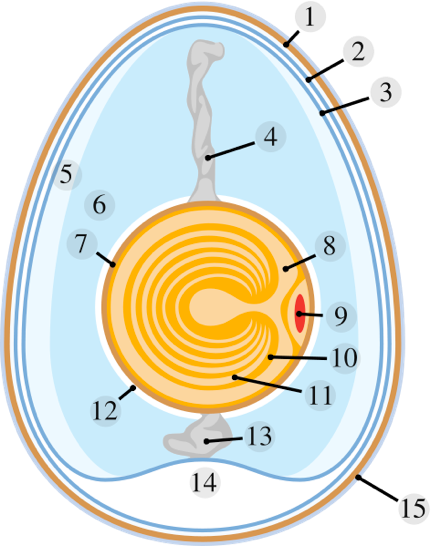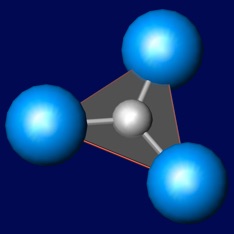Anatomy

The shape of an egg is an ovate spheroid with one end larger than the other end. The egg has cylindrical symmetry along the long axis.
An egg is surrounded by a thin, hard shell. Inside, the egg yolk is suspended in the egg white by one or two spiral bands of tissue called the chalazae (from the Greek word khalazi, meaning hailstone or hard lump.)
Below are the parts of a chicken egg. Most domesticated fowl have quite similar eggs; size and shape, as well as shell color will vary.
-
1.Eggshell
-
2.Outer membrane
-
3.Inner membrane
-
4.Chalaza
-
5.Exterior albumen (outer thin albumen)
-
6.Middle albumen (inner thick albumen)
-
7.Vitelline membrane
-
8.Nucleus of pander
-
9.Germinal disk (blastoderm)
-
10.Yellow yolk
-
11.White yolk
-
12.Internal albumen
-
13.Chalaza
-
14.Air cell
-
15.Cuticle (Bloom)
Eggshell
The eggshell is composed of a foamy layer of cuticle, a calcium carbonate/protein layer, and two shell membranes.
As an egg develops within a bird's reproductive system, the shell is laid down as a liquid mineral layer around the already-formed extraembryonic membranes. This takes place in a part of the bird's oviduct/uterus, and serves a very different purpose from the uterus of a mammal. The shell is laid down by shell glands.
In an average laying hen, the process of shell formation takes around 20 hours. Pigmentation (color), if any, is added to the shell by papillae lining the oviduct. Since eggs are usually laid blunt end first, that end is subjected to most pressure during its passage and consequently shows the most color. The cuticle is deposited on the shell in the vagina of the bird's oviduct.
Egg shell color is caused by pigment deposition during egg formation in the oviduct and can vary according to species and breed, from the more common white or brown to pink or speckled blue-green. In general, chicken breeds with white ear lobes lay white eggs, whereas chickens with red ear lobes lay brown eggs. Although there is no significant link between shell color and nutritional value, there is often a cultural preference for one color over another. For example, in most regions of the United States, chicken eggs are generally white; while in the northeast of that country and in New Zealand, Australia and the United Kingdom, they are generally light-brown. In many parts of Europe, white chicken eggs are regarded as industrial, and brown or reddish ones are preferred.
Bumpy and grainy in texture, an eggshell is covered with as many as 17,000 tiny pores. Eggshell is made almost entirely of calcium carbonate (CaCO3) crystals. It is a semipermeable membrane, which
means that air and moisture can pass through its pores. The shell also has a thin outermost coating called the bloom or cuticle that helps keep out bacteria and dust.
Cuticle
The thin outermost coating is called the bloom (in chicken eggs) or cuticle; it helps keep out bacteria and dust. Its thickness varies among different species and variety; it is a foamy layer, rich in protein.
Inner and Outer Membranes
Lying between the eggshell and egg white, these two transparent protein membranes provide efficient defense against bacterial invasion. If you give these layers a tug, you’ll find they’re surprisingly strong. They’re made partly of keratin, a protein that’s also in human hair.
Air cell
Because the body temperature of a hen is approximately 106° F, eggs are very warm at the time they are laid. The temperature of the air is usually much lower than 106°F, and the egg cools to the temperature of its surroundings. As cooling takes place, the contents of the egg contract more than does the shell of the egg. This creates a vacuum and air is drawn through the pores of the egg.
As a result, an air cell forms at the large end of the egg, usually between the outer and inner membranes. Chicken eggs are graded according to the size of this air cell, measured during candling. A very fresh egg has a small air cell and receives a grade of AA. As the size of the air cell increases, and the quality of the egg decreases, the grade moves from AA to A to B. This provides a way of testing the age of an egg: as the air cell increases in size, the egg becomes less dense and the larger end of the egg will rise to increasingly shallower depths when the egg is placed in a bowl of water. A very old egg will actually float in the water and should not be eaten.
White (albumen)
Egg white is the common name for the clear liquid (also called the albumen or the glair/glaire) contained within an egg. It is the cytoplasm of the egg, which until fertilization is a single cell (including the yolk). It consists mainly of about 15% proteins dissolved in water. Its primary natural purpose is to protect the egg yolk and provide additional nutrition for the growth of the embryo, as it is rich in proteins and is of high nutritional value. Unlike the egg yolk, it contains a negligible amount of fat.
The egg white is known as the albumen, which comes from albus, the Latin word for “white.” Four alternating layers of thick and thin albumen contain approximately 40 different proteins, the main components of the egg white in addition to water.
The egg white is approximately two-thirds of the total egg's weight out of its shell with 90% of that weight coming from water. The remaining weight of the egg white comes from protein, trace minerals, fatty material, vitamins, and glucose.
Chalazae
Opaque ropes of egg white, the chalazae hold the yolk in the center of the egg. Like little anchors, they attach the yolk’s casing to the membrane lining the eggshell. The more prominent they are, the fresher the egg.
Vitelline Membrane
The clear casing that encloses the yolk.
Yolk
The yolk contains less water and more protein than the white, some fat, and most of the vitamins and minerals of the egg. Yolk color ranges from just a hint of yellow to a magnificent deep orange, according to the feed and breed of the hen. Yolk color is dependent on the diet of the hen; if the diet contains yellow/orange plant pigments known as xanthophylls, then they are deposited in the yolk, coloring it. A colorless diet can produce an almost colorless yolk. Farmers may enhance yolk color with artificial pigments, or with natural supplements rich in lutein (marigold petals are a popular choice), but in most locations, this activity is forbidden.
The yolk in a newly laid egg is round and firm. As the yolk ages it absorbs water from the albumen which increases its size and causes it to stretch and weaken the vitelline membrane (the clear casing enclosing the yolk). The resulting effect is a flattened and enlarged yolk shape.
The egg yolk is the part of an egg which serves as the food source for the developing embryo inside. Prior to fertilization the yolk together with the germinal disc is a single cell. It is one of the few single-cells that can be seen by the naked eye. The egg yolk is suspended in the egg white (known more formally as albumen or ovalbumin) by one or two spiral bands of tissue called the chalazae.
Double yolk eggs
Double yolk eggs occur when ovulation occurs too rapidly, or when one yolk becomes joined with another yolk. These eggs may be the result of a young hen's productive cycle not yet being synchronized.
No yolk eggs
No-yolkers are called "dwarf" or "wind" eggs. Such an egg is most often a pullet's first effort, produced before her laying mechanism is fully geared up. In a mature hen, a wind egg is unlikely, but can occur if a bit of reproductive tissue breaks away, stimulating the egg producing glands to treat it like a yolk and wrap it in albumen, membranes and a shell as it travels through the egg tube. You can tell this has occurred if, instead of a yolk, the egg contains a small particle of grayish tissue.
An archaic term for a no yolk egg is a "cock" egg. Since they contained no yolk and therefore can't hatch, our forebears believed they were laid by roosters. This type of egg occurs in many varieties of fowl. They have been found in chickens, both standard and bantams, guineas and Coturnix Quail.
These are also Eggs that turn rotten (green inside) after the hen has laid the eggs and all eggs have hatched.
Back to Main Eggs page
Back to Main Supplies page
Back to MAIN Pysanka home page.
Back to Pysanka Index.
Schematic of a chicken egg





